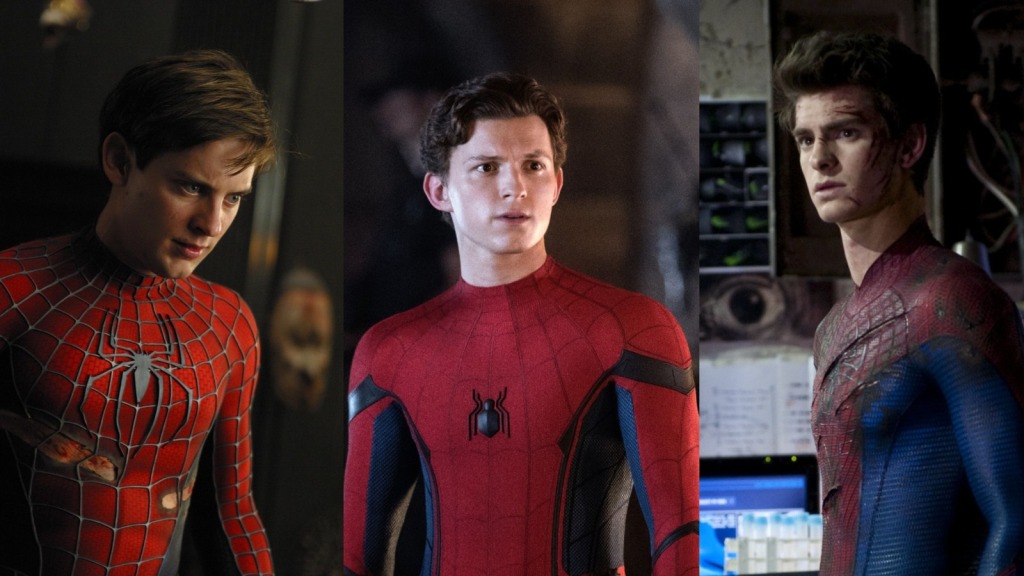
Is it past time for Spider-Man to grow up, OpinionNerds?
I feel like like the, “modern day Danny Glover” because every new thing that comes out of the pop culture mills these days leaves me thinking that I’m just to goddamned old for this shit. Increasingly, that appears to be something the character of Spider-Man will never be, and I’m beginning to wonder, despite it’s near universal popularity, if that’s such a good thing.
Sony Pictures has held the feature film rights to Spider-Man and his related characters for over two decades, producing three series of films; one from legendary filmmaker Sam Raimi in the early 2000’s, one from director Marc Webb in the early 2010’s and one in direct partnership with Marvel Studios from director Jon Watts as part of their Marvel Cinematic Universe. Since 2002 the world hasn’t gone more than five years without a live action Spider-Man on screen in some capacity and, despite the popular thought, all of them have been successful to some degree.
Each of these two series has a specific narrative approach meant to elicit different emotional responses from the audience. Sam Raimi’s trilogy of films attempt to capture the exaggerated comic book world, but they follow the journey of Peter Parker as he matures, with the responsibilities of being Spider-Man serving as an apt metaphor for the responsibilities that go along with being an adult. Marc Webb was only able to produce two films with the character, placing them in a less exaggerated and more, “realistic” world – at least initially (don’t get me started). But by the end of the second film, the loose metaphor still becomes about growth; taking the painful lessons of life and learning to move forward. While both series begin with the character as a teenager, owing to its literary origin, they both see the character quickly moving towards adulthood through the usual milestones of high school graduations, relationships and loss. While they may take different approaches, each of these filmmakers seems very interested in having the audience share in the experience of growth along with the character.
The MCU series from Jon Watts attempts to circumvent the origin trope by not engaging in the known story of how Peter Parke became Spider-Man while still introducing the character as a teen. This version of Spidey has appeared in double the number of films the Sam Raimi version had starting with Captain America: Civil War in 2016, with the latest Spider-Man: No Way Home in 2021 marking Tom Holland’s sixth big screen outing as the character in 5 years. Yet in that time the character has passed very few milestones on the way to maturity. Between these films and the spate of animated projects over the last few years, Marvel seems to have a vested interest in maintaining the image of Peter Parker as a high school hero in the publics eye. Interestingly, this wasn’t always the case, and it seems to be a fairly recent phenomena.

Peter-Parker was introduced to the world as a high school student when he first appeared in Amazing Fantasy #15 back in 1962, before getting his first solo title seven months later. Though difficult to chart in comic time, which moves more slowly than our reality, the character aged relatively quickly, graduating high school in 1965 and entering college, where the majority of the characters life took place in the 1970’s and early 1980’s. The short lived late 70’s television series starring Nicholas Hammond as Peter Parker began with the character as a young adult already in college before he’s bitten by the spider. While the 1967 animated adaptation featured the character as a teen for three years, the 1980’s animated series The Amazing Spider-Man and Spider-Man and his Amazing Friends, as well as the 1994 Spider-Man and its sequel, Spider-Man Unlimited, featured the characters portrayed in its early to mid 20’s.
Since it’s still difficult to gauge the passage of time in comics it was generally understood that throughout the 80’s and 90’s, Peter was perpetually in his mid 20’s. Presumably the mindset was if you wanted to tell more sophisticated and dramatic stories you needed a character that was old enough to believably shoulder the traumas that go along with them. There is also the general idea that a younger audience looks to their elders for guidance on how to model themselves as adults. If your audience is younger children, you give them characters in their teens. And if your target audience is made up of teens, you make the characters young adults. Of course this is context dependent. For instance, the Peter Parker that appeared in the animated film Into The Spider-Verse was an adult approaching middle age. However the main character of the film was the much younger Miles Morales, who looked to Peter as somewhat of a mentor.
When Marvel began publishing Ultimate Spider-Man in 2000, it understandably hit the rest button on the character. The Ultimate Marvel series was an experiment in creating a tightly connected narrative continuity between all its titles, growing them from a consistent set of elements going so far as to serve as an early roadmap for the connected film universe. With that continuity growing in front of our eyes, starting Peter young gave him a unique and definitive space to occupy in that world. The approach was a huge hit, with the Ultimate version of Spider-Man becoming more or less the definitive public face of the character for much of the 2000’s. Elements of the series would make their way into both the Raimi and Webb films, and it’s influence could be seen in almost every new Spider-Man adaptation of the 2000’s. It also sent a message to Marvel that what resonated with Spider-Man’s audience was the image of him as an adolescent hero fighting bad guys and dealing with being a kid.
The Ultimate Spider-Man series ran for 11 years, concluding with the (temporary) death of Peter Parker. After that a new Spider-Man was created, that of the slightly younger Miles Morales, who takes the mantle at 13 (Peter is commonly understood to be 15 when he gets his powers). Between the two characters, the most popular versions of Spider-Man in the 2000’s had been teenagers, as the timeline of the books prevented Peter from aging up. In that time, the Peter Parker of the main comics continuity underwent a series of retcons and soft reboots that, while not actually de-aging the character, removed many of the milestones that marked his adult growth, such as his marriage, and generally creating the image of a character in his early 20’s. Discounting Spider-Man: The New Adventures, a CG animated spin off of the Sam Raimi film that ran for one season on MTV, Spider-Man has had five new animated series between 2008’s The Spectacular Spider-Man and the upcoming Spider-Man: Freshman Year, which is set in the MCU continuity. The only modern adaptation of the character to feature it both as an adult and the subject of the storytelling has been the PS4/5 video game Marvel’s Spider-Man, whose sequel follows the, again, much younger Miles Morales.

For the last 20 years, every new adaptation of the Spider-Man world has returned Peter Parker to being a teenager, with only the older films even having him so much as graduate high school. Despite the character spending the great majority of its 60 year printed life as a young adult, the current image of the character in pop culture is that of a socially awkward 15 year old. And because virtually every new iteration of the character is reset to a younger age, the stories told remain limited by the experiences a character of that age can believably have.
With Spider-Man pulling in over a Billion dollars a year in merchandising, much of it from material produced for younger skewing consumers, there is a practical reason to keep the character accessible to that audience. The last animated adaptation, Spidey and His Amazing Friends, was produced for Disney Junior, a network whose target audience is 2 to 7 year olds. And despite the fact that its core consumer group is between 18 and 35, the MCU produces YA material with a target demo of 12 to 18. There is a solid financial stake in keeping Peter Parker in the teen hero game and, barring that, replacing him with the younger Miles Morales to keep the brand on track. While this makes business sense, it does bare asking if this is limiting what can be done with the character as a matter of storytelling. The current films make for good spectacle but, if the character can never shoulder any real trauma due to the intended age of its audience, does that spectacle have any merit beyond how good it looks?
Is there a creative advantage to keeping the character a perpetual adolescent? If the character is relegated to material in which the kinds of events that force growth, events often accompanied by tragedy and pain, cannot be rendered in a meaningful way due to demographic limitations, what does that leave for storytelling? One of the main criticisms of the MCU approach to the character is that it hasn’t been allowed to face great personal challenge and change, and that it’s been mostly protected from having to endure any true hardship. In fairness, that aspect of the character has rarely translated to animation, as that medium is still seen as the domain of programming intended for children. But it was a core ingredient in both the Raimi and Webb films. I’ve often remarked in these spaces that one of the key features that separates animation from live action when it comes to storytelling is the weight of believability live action carries that translate emotions in ways that animation often doesn’t. We react to the sight of human beings differently than we react to a human like image, no matter how well its drawn. I firmly believe that is one of, if not the key reason, storytellers want to tackle these characters in live action; to bring that dramatic weight of believable reality to these stories. Without that you’re just making photo-real animated films that have live action segments, and the value of that only goes so far.
Maybe it really is just as simple as this; Marvel and Disney have come to the conclusion that young audiences prefer the characters they follow to be closer to their age. In the last decade the publisher has introduced a number of younger ersatz characters to carry on the legacy of many of their popular IP’s in an attempt to either reach a diversified audience of new readers, or to protect certain trademarks and copyrights depending on which conversation you’re having. The fact that characters at this age are kept from experiencing the kinds of tragedies adults face may be just as much about how they have become less about being companions the audience can look up to than being identifiable avatars they can imagine themselves as. And, really; who wants to be the character who life is constantly kicking in the balls?
So how did we get here? Honestly, I don’t know. Comic books have never been at a loss for teenage heroes to serve as peers for the audience, but they almost always accompanied adult heroes who functioned as their mentors or, in the case of 10 year old Billy Batson, their magical alter ego. Spider-Man was one of the first teenage solo heroes, but again, those years didn’t last very long, and for some time the character seemed to more or less age with its readership. But even as an adult character with some complex stories behind it, Marvel never had an issue selling Spider-Man to a younger audience. Kids have always been able to separate the image of Spider-Man, the red and blue web slinger zipping across the sky, from the character of Peter Parker, the perpetually broke young adult just trying to get through life. As the audience aged, they grew into his adult adventures when they reached those same growth milestones, looking to the character as an example of how to deal with them. If the characters age is reset with every new iteration, those fans will have to look elsewhere for a companion as Peter goes back to dealing with jock bullies and school dances. With the state of American super hero comics being what it is, those options are becoming increasingly limited.
Spider-Man has always been a character split between the imagery of its high flying, acrobatic action and the depth of storytelling going all the way back to the seminal death of Uncle Ben in 1962. In the years since that fateful night, the character has been allowed to grow from a scrawny teenager into a mostly functioning adult without losing any of the wit or spunk that made him a fun hit with snarky kids looking to emulate his wisecracking ways. But as the characters age has been limited to a handful of teenage years in order to better secure an audience demographic, are we losing the weight of drama that goes along with the pain of learning to be a grown up? This path of growth has been a long running metaphor in the world of Spider-Man as part of his learning the great responsibility that comes with great power. The lessons of adulthood are very different from the lessons we learn as a child, and if the character is never allowed to become an adult, never allowed to face those traumas, tragedies and challenges, how can it serve as an example for its young fans to follow? Spider-Man has always been marked by its abilities to take all of lifes punches and keep on web-swinging. It’s difficult to see it having the same value if the hardest choice it ever has to make is whether or not to go to prom.
Clever endings aren’t my bag.
Laterz

